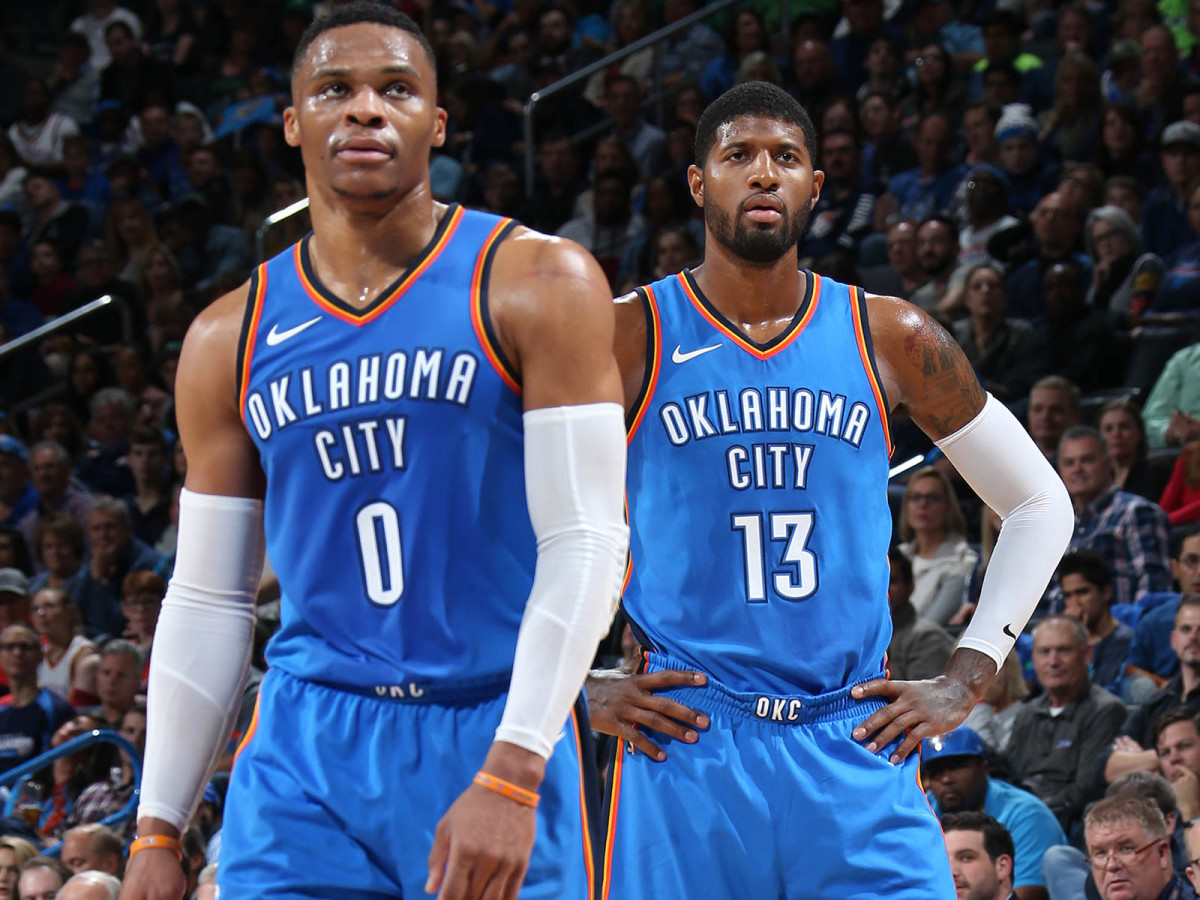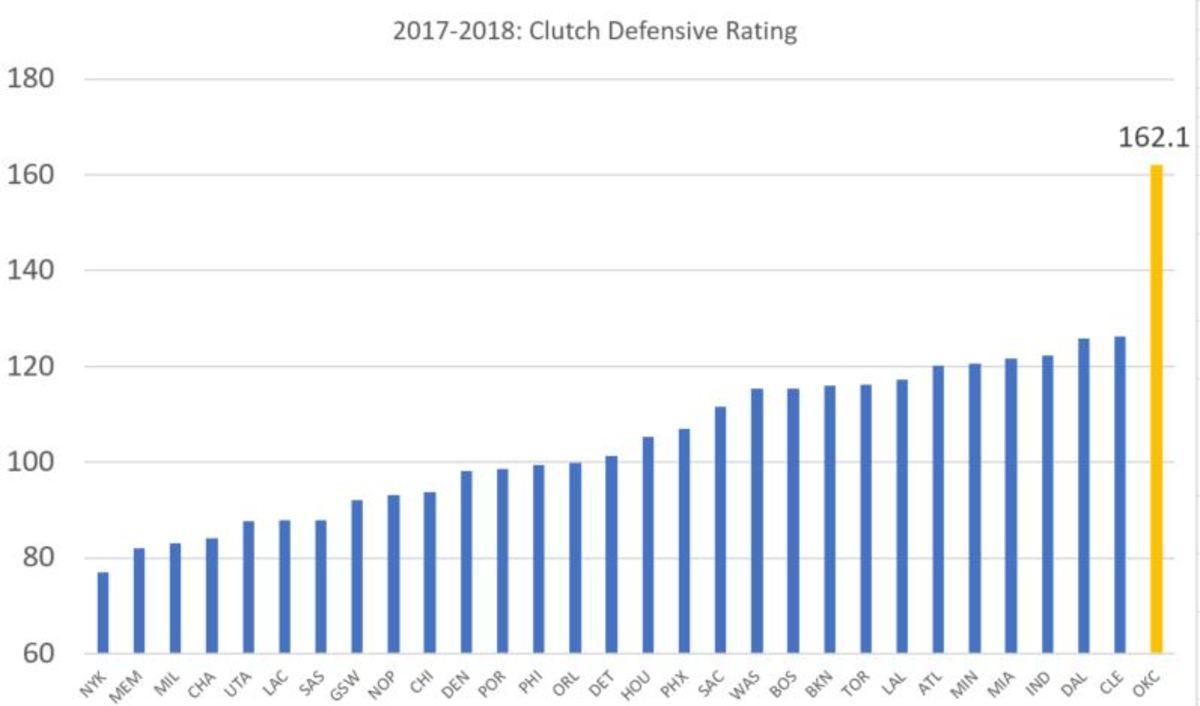The Welcome Party Is Over for Paul George in OKC

The Thunder pulled out all the stops when they traded for Paul George in June, throwing the All-Star forward a lavish welcome party with one eye on the playoffs and the other on his 2018 free agency. That especially warm embrace was the first step of a shrewd and self-aware retention strategy, one designed to frame the Thunder as a family that cares, not merely a brand-building platform. What Oklahoma City might lack in nightlife or glamour, the pitch went, it makes up for with everything a star could desires: a winning environment, an MVP captain in Russell Westbrook, a proven GM in Sam Presti, a low-key ownership group, and an ultra-passionate fan base.
Three weeks in, George has every right to wonder whether the Thunder will be able to deliver on their vision.
Put aside Chris Paul and Isaiah Thomas, both of whom are sidelined with injuries, and George has endured the rockiest start to 2017-18 of any prominent star traded this calendar year. Unlike Kyrie Irving, he hasn’t enjoyed a profile boost as the face of a franchise. Unlike Jimmy Butler, his individual sacrifices haven’t led to immediate team success. And unlike DeMarcus Cousins, he hasn’t even been in position to post crazy numbers.
Acclaim? Nope. Winning? Not yet. Stats? Not really. Remember, George is a 27-year-old scoring forward with a signature shoe, a sports drink commercial, and a first date with unrestricted free agency in just eight months. Under normal circumstances, he should be peaking on all fronts.
Pacers Newcomers Prove There's Power in Freedom
The story in Oklahoma City so far has been one of regression, rather than ascension. George has been squeezed on both sides by Westbrook and Carmelo Anthony, left with that trio’s third-highest usage rate. Compared to last year, George’s scoring is down, his shots are down, and his assists are down. Meanwhile, his touches, time of possession and free-throw attempts are all way down.
To make matters worse, he doesn’t have much to show for that narrowing role: His shooting efficiency has fallen overall, Oklahoma City’s star-studded headliners haven’t really clicked, and he’s largely been a crunch-time bystander as the Thunder have compiled an 0-6 record in close games. If voting were conducted today, George would be left off the West’s All-Star team and he would be on the outside looking in at the All-NBA conversation.
Playing with a high-level point guard for the first time in his career should theoretically be a godsend. Instead, the arrangement has often left George looking like an afterthought. As Oklahoma City fell to Portland, Sacramento and Denver in succession this week, George shot just 3 of 10 combined in the fourth quarter. In 23 minutes of clutch play this season, George has attempted just eight shots to Westbrook’s 18. It’s difficult to accumulate enough footage to film a Gatorade commercial when you only get to shoot once every three minutes with the game on the line.

To George’s credit, he’s yet to raise a fuss, in contrast to his loud squawking in Indiana over his late-game role during the 2017 playoffs. Following an ugly loss to the Kings earlier this week, he diplomatically stated that the Thunder “have a whole year to figure it out.” He’s also done very well to make his presence felt defensively, leading the NBA in both steals and deflections.
Preaching patience is standard operating procedure for any team in early November, much less one trying to quickly merge three alphas who share a tendency to shoot to much. But there are red flags aplenty in Oklahoma City’s early body of work, starting with the mediocre play of the Westbrook/George/Anthony trio.
Oklahoma City’s new Big 3 has posted a -0.7 net rating through 11 games. Aside from spanking the Bucks and a nice first-half against the Celtics, the Thunder have yet to demonstrate the ability to form a whole greater than the sum of its parts against a quality opponent.
This is particularly ominous because Presti sacrificed his already limited depth to acquire George and Anthony, trading away four rotation players (Victor Oladipo, Domantas Sabonis, Enes Kanter and Doug McDermott) for the promise of two stars. The result has been a top-heavy roster whose top simply isn’t pulling enough weight compared to recent comparison points. Last year, the Westbrook/Oladipo/Steven Adams trio posted a +6.7 net rating. The year before, Westbrook/Kevin Durant/Serge Ibaka played at a championship-caliber +12.3 net rating.
There isn’t a simple fix to make OKC's Big 3 hum. Westbrook’s own scoring and usage are down sharply this year; He’s trying, albeit very awkwardly, to clear room for his new sidekicks. Expecting the 33-year-old Anthony to dramatically rework his game is a fool’s errand. As per expectations, he’s been a capable catch-and-shoot target for Westbrook’s passes and a persistent weak link on the defensive end. That’s who he is, whether or not he dons the mythical hooded sweatshirt.
All three of Oklahoma City’s stars are too willing to pound and settle, but they are also encouraged to revert to those bad habits by lineups that feature at least one, and sometimes two, non-scoring threats. Too often, a bad jumper by George or Anthony goes up because it’s still a better idea than a good Andre Roberson jumper. There also isn’t much ball movement or systemic support to grease the skids, as Oklahoma City ranks dead last by making just 256.2 passes per game. Playing Westbrook and Raymond Felton together would theoretically help the Thunder’s flow, but doing so requires trade-offs on the defensive end.
Speaking of defense, Oklahoma City’s calling card has turned into its Achilles heel in crunch time. The NBA’s second-ranked defense drops to dead last in the clutch, posting an abominable 162.1 defensive rating in the last five minutes of games decided by five or fewer points. A chart comparing Oklahoma City’s clutch defense to the other 29 teams looks like a typographical error.

Why, exactly, does Oklahoma City’s defense turn into a funnel when it matters? One persistent area of exploitation has been its lack of rim protection aside from Adams. All four opponents during Oklahoma City’s current losing streak have found success by pulling Adams away from the hoop—either in high pick-and-rolls or simply by deploying scoring big men above the elbow—so that Anthony and wings like George and Andre Roberson were left as the back-side defenders. That simple strategy has led to a parade of lay-ups from cutters, lots of forced fouls to prevent dunks, and quality kick-out threes once Oklahoma City’s defense collapses in panic.
In postseasons past, Adams had Ibaka and Durant, players with significant length and shot-blocking ability, to provide cover. The current Thunder have no players fitting that bill, least of all Anthony. This looms as a long-term concern given that Adams, as a traditional center, isn’t ideally suited to covering stretch fives. On paper and so far in practice, Oklahoma City’s preferred closing lineup includes both a center who can’t always cover distance quickly enough to challenge three-point shooters and a power forward who can’t contest shots above the rim. That’s problematic.
Oklahoma City’s clutch play, and especially its clutch defense, will improve because there’s nowhere to go but up. Repetitions are crucial for a team with so many new pieces and new roles. It’s also reasonable to expect that Westbrook will take his game to another level, responding to the Thunder’s losing streak by deferring less and taking on a greater scoring burden. As last year proved, his force of will can be a winning formula all by itself, at least in the regular season.
The problem there, though, is that while more Westbrook might be better for the Thunder, it probably won’t be better for George. A true return of kamikaze Westbrook would necessarily come at the expense of George, Anthony or both. Meanwhile, it would take Oklahoma City even further away from the Westbrook/George superstar tandem image that had to be scrapped upon Anthony’s late-summer arrival.
Given the prospect of George’s impending free agency and the massive luxury tax payments required to keep this core group together, Presti and company are already at the point where they need to show major progress on the question that will define the organization’s next chapter.
What can the Thunder do to improve Paul George’s life?
